($120, Robert Katcher Selections): 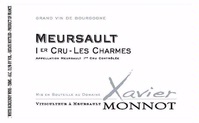 Combine the richness inherent to the wines from Les Charmes vineyard and the warm 2012 growing season and you get, not surprisingly, an opulent wine. The surprise is its vivacity and brightness, which Monnot attributes to the 50+ year-old vines. … Read more
Combine the richness inherent to the wines from Les Charmes vineyard and the warm 2012 growing season and you get, not surprisingly, an opulent wine. The surprise is its vivacity and brightness, which Monnot attributes to the 50+ year-old vines. … Read more
All posts by admin
Xavier Monnot, Volnay 1er Cru (Burgundy, France) Clos des Chenes 2012
($85, Robert Katcher Selections): One whiff of this wine explains the reputation of Volnay and why the wines from this village are in such great demand. Most experts consider Clos des Chenes one of the best premier cru vineyards in this village that lacks any grand crus. … Read more
Xavier Monnot, Maranges 1er Cru (Burgundy, France) Clos de la Fussière 2012
($45, Robert Katcher Selections): Though wine has been made in Maranges for centuries, the appellation is relatively new for Burgundy, having been established only in 1988. Prior to that date, the wines were sold under the broad Côte de Beaune Villages umbrella. … Read more
Pahlmeyer, Napa Valley (California) “Jayson” 2012
($75): Pahlmeyer, the $150-a-bottle Bordeaux blend, has become one of the “hot” Napa Valley wines. Jayson, made entirely from Cabernet Sauvignon, is Pahlmeyer’s second wine. It’s no shrinking violet. Inky purple, it’s juicy and concentrated with heaps of dark, blueberry-like fruit flavors. … Read more
Rodney Strong, Alexander Valley (Sonoma County, California) Cabernet Sauvignon Reserve 2012
($40): With its ripe dark fruit character, Rodney Strong’s 2012 Cabernet Sauvignon clearly reflects its origins, the Alexander Valley, the second warmest (behind Knights Valley) AVA of Sonoma County. The dense black fruit character is laced with allspice and other exotic notes. … Read more
Rodney Strong, Alexander Valley (Sonoma County, California) “Symmetry” 2012
($55): 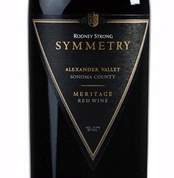 Similar to Rodney Strong’s 2012 Cabernet Sauvignon, their Meritage wine, Symmetry, a blend of Cabernet Sauvignon (75%), and other Bordeaux varieties (Merlot, Cabernet Franc, Malbec and Petit Verdot), is big and ripe with a seductively plush texture. With the blend, however, comes complexity, which becomes even more apparent as the wine sits in the glass. … Read more
Similar to Rodney Strong’s 2012 Cabernet Sauvignon, their Meritage wine, Symmetry, a blend of Cabernet Sauvignon (75%), and other Bordeaux varieties (Merlot, Cabernet Franc, Malbec and Petit Verdot), is big and ripe with a seductively plush texture. With the blend, however, comes complexity, which becomes even more apparent as the wine sits in the glass. … Read more
Col D’Orcia, Rosso di Montalcino (Tuscany, Italy) 2010
($43): Col D’Orcia, one of the top producers of Brunello di Montalcino, made a stunning Rosso di Montalcino in 2010. It’s not surprising since 2010 was truly a great vintage for the region and Col D’Orcia has always embraced the second wine of the region. … Read more
Monteverro, IGT Toscana Rosso (Italy) “Monteverro” 2011
($150, Opici Imports): Monteverro, who just planted their first vines in 2004, is aiming to enter the elite three digit price club of the Super Tuscans, led by Ornellaia and Sassicaia. They are located, like those two icons, in Maremma, though in a warmer area about 100 south of them. … Read more
Sesti, Brunello di Montalcino (Tuscany, Italy) 2010
($55): The vast range of Brunello I tasted at Benvenuto Brunello, the annual event in Montalcino at which the Brunello producers show their soon-to-be-released new vintage, convinced me that 2010 is one the truly great vintages for that DOCG. In my view, Brunello lovers cannot have too many 2010s in their cellars. … Read more
Bila-Haut, Côtes du Rousssillon Villages Latour de France (Languedoc, France) “Occultum Lapidem” 2013
($30, HB Wine Merchants): Michel Chapoutier, the renowned Rhône producer, has a personal estate in the Languedoc, called Bila-Haut. Latour de France (not to be confused with the bicycle race) is one of the four specific towns that have the potential to produce more distinctive wine and are allowed to append their names to the more encompassing Côtes du Rousssillon Villages appellation, much like the better villages in the Rhône can attach their names to the Côtes du Rhône Villages appellation.… Read more
Caves de Lugny, Mâcon-Villages (Burgundy, Franc) “La Côte Blanche” 2013
($12, Pasternak Wine Imports): Caves de Lugny, the largest cooperative in Burgundy, controls about one-third of the entire production of the Mâconnais region. I, unlike many, do not subscribe to the notion that large producers are incapable of making high quality wine. … Read more
Henri Prudhon, St. Aubin (Burgundy, France) Les Argillers 2010
($30, Rosenthal Wine Merchant): St. Aubin, an off the main road village in Burgundy, is known mostly for whites, which, because of recent popularity, has already resulted in considerable prices increase for those Chardonnay-based wines. The reds, made exclusively from Pinot Noir, such as this one, remain relatively undiscovered–and therefore, reasonably priced. … Read more
La Lastra, Vernaccia di San Gimignano (Tuscany, Italy) 2013
($15): La Lastra is one of leading producers of Vernaccia di San Gimignano, an often-overlooked DOCG. With its cutting edge and slightly nutty finish, La Lastra’s 2013 could be the poster child for the appellation. This bright and energetic wine is perfect for linguine and clam sauce or simple broiled fish.… Read more
Querciabella, Chianti Classico (Tuscany, Italy) 2012
($32, Maison Marques & Domaines): 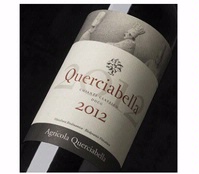 Querciabella, one of the stellar producers in the Chianti Classico region, does not rest on their laurels. They are in the process of making Chianti Classico from several of the subregions of that DOCG, which will give consumers an opportunity, at long last, to discern the differences among the areas in the Chianti Classico region since the winemaking will be constant. … Read more
Querciabella, one of the stellar producers in the Chianti Classico region, does not rest on their laurels. They are in the process of making Chianti Classico from several of the subregions of that DOCG, which will give consumers an opportunity, at long last, to discern the differences among the areas in the Chianti Classico region since the winemaking will be constant. … Read more
Castello di Verrazzano, Chianti Classico (Tuscany, Italy) 2012
($23): A traditional producer, Verrazzano uses only Sangiovese and Canaiolo for their Chianti Classico, reserving Cabernet and Merlot, the so-called international varieties, for their Super Tuscan bottling. Their powerful style is readily apparent with this 2012 Chianti Classico. Despite its concentration, the wine is balanced with an interplay of dark cherry-like fruit and savory elements all enlivened by refreshing acidity. … Read more
Antinori, Brunello di Montalcino (Tuscany, Italy) “Pian delle Vigne” 2010
($62): It should come as no surprise that Antinori, who, as much as anyone, is responsible for the quality of Tuscan wines, should produce an outstanding Brunello. They certainly have with their 2010 Pian delle Vigne. Lofty aromatics predict an exciting wine. … Read more
Poggio di Sotto, Brunello di Montalcino (Tuscany, Italy) 2010
($160): Poggio di Sotto, one of the region’s traditional producers, made one of the top wines of the vintage in 2010. Though not a powerhouse, there’s plenty going on in Poggio di Sotto’s 2010 Brunello. The first whiff tells you it’s something special. … Read more
Maison Joseph Drouhin, Chorey-les-Beaune (Burgundy, France) 2012
($28, Dreyfus Ashby & Co.): Chorey-les-Beaune, a small village just north of Beaune, is a sleeper location for value packed red Burgundy, such as this one. Lying just off the main Dijon Beaune road, Chorey, as it’s sometimes called, is off most everybody’s radar screen. … Read more
Nieto Senetiner, Mendoza (Argentina) Malbec “Camila” 2013
($10, Foley Family Wines):  Full disclosure, Malbec is not my favorite wine because all too often I find it overblown and just too big. So imagine my surprise when I ran across this one. It’s refined — not a word commonly used to describe Malbec — with a lovely texture and freshness. … Read more
Full disclosure, Malbec is not my favorite wine because all too often I find it overblown and just too big. So imagine my surprise when I ran across this one. It’s refined — not a word commonly used to describe Malbec — with a lovely texture and freshness. … Read more
Nieto Senetiner, Mendoza (Argentina) Bonardo 2012
($13, Foley Family Wines):  Bonarda may, indeed, rival Malbec for Argentina’s top red grape. This extraordinary value example shows why. A hearty red with even a hint of tarriness, this Bonarda has polished tannins, making it a great choice for robust beef dish now. … Read more
Bonarda may, indeed, rival Malbec for Argentina’s top red grape. This extraordinary value example shows why. A hearty red with even a hint of tarriness, this Bonarda has polished tannins, making it a great choice for robust beef dish now. … Read more
Nieto Senetiner, Valle de Cafayate (Salta, Argentina) Torrontés 2013
($11, Foley Family Wines):  Torrontés, Argentina’s signature white grape, is gaining in popularity as consumers realize the zingy wine, such as this one, it can produce and, at a bargain price. Fresh, clean and zippy, Nieto Senetiner’s curiously has a whiff of mintiness that lends roundness, which actually allows consumer to enjoy it as a stand-alone aperitif. … Read more
Torrontés, Argentina’s signature white grape, is gaining in popularity as consumers realize the zingy wine, such as this one, it can produce and, at a bargain price. Fresh, clean and zippy, Nieto Senetiner’s curiously has a whiff of mintiness that lends roundness, which actually allows consumer to enjoy it as a stand-alone aperitif. … Read more
Nieto Senetiner, Mendoza (Argentina) Pinot Noir 2013
($13, Foley Family Wines):  Pinot Noir is not likely to replace Malbec as Argentina’s signature red grape, but this wine will still get your attention. Thankfully, not overworked, this Pinot Noir is fruity and fresh. To their credit, Nieto Senetiner is keeping it simple with this bright Pinot Noir, not trying to make a bargain-priced wine into something “important.” … Read more
Pinot Noir is not likely to replace Malbec as Argentina’s signature red grape, but this wine will still get your attention. Thankfully, not overworked, this Pinot Noir is fruity and fresh. To their credit, Nieto Senetiner is keeping it simple with this bright Pinot Noir, not trying to make a bargain-priced wine into something “important.” … Read more
Bolla, Valpolicella Classico Superiore Ripasso (Veneto, Italy) “La Poiane” 2011
($15, Banfi): Valpolicella is often considered a not terribly substantial light red wine. This wine erases that image. Think of Bolla’s La Poiane as a Valpolicella on steroids. The grapes come from the best area of Valpolicella (Classico) and have attained better ripeness (Superiore). … Read more
Castello Banfi, Rosso di Montalcino (Tuscany, Italy) 2012
($22, Banfi): Rosso di Montalcino, often dubbed “Baby Brunello,” gives consumers a glimmer of the grandeur of the more prestigious appellation at a more affordable price. And, unlike Brunello itself, wines carrying the Rosso di Montalcino name are ready to drink upon release.… Read more
Castello di Fonterutoli, Chianti Classico (Tuscany, Italy) 2013
($14): Castello di Fonterutoli’s 2013 Chianti Classico is a riper and fleshier rendition, without going over the top. It’s a very clean and pure expression of Chianti Classico with an attractive succulence in the finish. Freshness in the finish holds it all together. … Read more
Castello di Ama, Chianti Classico (Tuscany, Italy) 2013
($19): Castello di Ama, a top producer of Chianti Classico, make a splendid range of wines from this one, to their Chianti Classico Riserva to their Chianti Classico Gran Selezione. This 2013 is a traditionally framed Chianti Classico that conveys a mixture of dark slightly bitter cherries and a savory earthiness. … Read more
Máté, Brunello di Montalcino (Tuscany, Italy) 2010
($45): Máté, a relative newcomer to Montalcino being founded in the 1990s, made a stellar Brunello in 2010. Powerful, without being overdone, their 2010 is more fruit forward and accessible than many of the other Brunello from the 2010 vintage. A dark core of minerality balances and enhances the ripe dark cherry fruit favors. … Read more
Mocali, Brunello di Montalcino (Tuscany, Italy) 2010
($40): Mocali made it into my list of top Brunello of 2010 with its impressive aromatics and gorgeous initial impact of dried and ripe fresh cherries offset by dense dark minerality. A lovely firmness and hint of bitterness round out this beautifully balanced wine. … Read more
Mastrojanni, Brunello di Montalcino (Tuscany, Italy) 2010
($60): Mastrojanni’s 2010 Brunello, one of the top wines of the vintage, has gorgeous power balanced by suave elegance. An engaging floral aspect suggests greatness. What follows doesn’t disappoint. Polished, almost sweet, tannins surround a core of dark earthy minerality. Succulent dark black cherry-like flavors emerge with time. … Read more
Lisini, Brunello di Montalcino (Tuscany, Italy) 2010
($60): 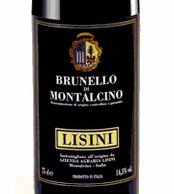 No doubt I will say more than once that the 2010 vintage for Brunello is outstanding — as good as it gets. Lisini, a traditional producer who rarely falters, made one of the star wines of the vintage. With an enormous initial aromatic impact, their 2010 delivers an alluring combination of flavors — earth and cherries — wrapped in firm, but polished, tannins. … Read more
No doubt I will say more than once that the 2010 vintage for Brunello is outstanding — as good as it gets. Lisini, a traditional producer who rarely falters, made one of the star wines of the vintage. With an enormous initial aromatic impact, their 2010 delivers an alluring combination of flavors — earth and cherries — wrapped in firm, but polished, tannins. … Read more
Simonnet Febrve, Chablis Grand Cru (Burgundy, France) Les Clos 2012
($80, Louis Latour USA): Chablis was more successful than the Côte d’Or for white wines in 2012. Indeed, the 2012 vintage produced excellent Chablis. The Simonnet Febrve style of tightly wound, mineraly-infused, bracing wines is ideally suited to this vintage, which produced ripe grapes.… Read more
Joseph Drouhin, Bourgogne Blanc (Burgundy, France) “Laforêt” 2012
($14, Dreyfus Ashby & Co.): 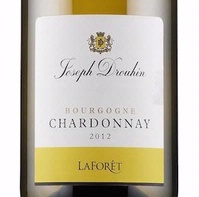 The firm of Joseph Drouhin, one of Burgundy’s best, is still family owned and operated. Though they own vineyards extensively throughout the region, they also have a talent for buying grapes and wines from other growers, blending them as needed, and bottling them under the Drouhin name. … Read more
The firm of Joseph Drouhin, one of Burgundy’s best, is still family owned and operated. Though they own vineyards extensively throughout the region, they also have a talent for buying grapes and wines from other growers, blending them as needed, and bottling them under the Drouhin name. … Read more
Vernaccia di San Gimignano
Consumers can be excused if they have no familiarity with Vernaccia di San Gimignano. A well-respected California-based wine writer (who shall remain nameless) recently admitted to me that (s)he didn’t even know that Vernaccia was a grape, let along that Vernaccia di San Gimignano was considered one of Italy’s great white wines. … Read more
Chianti: Confusing, But Worth Understanding
Americans love Chianti. Even those who rarely drink recognize the wine. It has the kind of name recognition that other wines can only dream about. Annually, we Americans actually drink almost twice as much Chianti Classico–wine from Chianti’s most important sub-region–as the Italians do.… Read more
Merry Edwards, Russian River Valley (Sonoma County, California) Pinot Noir “Angel Wing” 2011
($90): 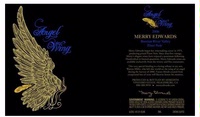 A tribute to her son, Warren, who died in 2006, this is a monumental Pinot Noir, in the best sense of the word. One whiff predicts its grandeur. What follows is a glorious explosion of flavors — smoky, fruity, earthy — that flow seamlessly one into another.… Read more
A tribute to her son, Warren, who died in 2006, this is a monumental Pinot Noir, in the best sense of the word. One whiff predicts its grandeur. What follows is a glorious explosion of flavors — smoky, fruity, earthy — that flow seamlessly one into another.… Read more
Caiarossa, IGP Maremma (Tuscany, Italy) 2010
($85): The 2010 Caiarossa, an extraordinary wine and the best from this estate since its commercial debut with the 2004 vintage, shows how far this producer has come in a very short time. Owned by same Dutch family who own the Margaux classified growths Château Giscours and Château du Tertre, and whose general manager, Alexander Van Beek, runs those two Bordeaux properties, Caiarossa uses a seeming mishmash of grapes — Bordeaux varieties, Syrah and even Alicante — to make this impressive Super Tuscan. … Read more
Castello di Uzzano, Chianti Classico (Tuscany, Italy) 2012
($18): The wines from Castello di Uzzano always show well at the comprehensive tasting of Chianti Classico held in Florence every year. They use only Sangiovese — Cabernet need not apply — for their Chianti Classico and avoid small oak barrels to allow the flavors of the region to shine. … Read more
Castellare di Castellina, Chianti Classico (Tuscany, Italy) 2013
($20, Winebow): Castellare di Castellina, one of my favorite Tuscan producers, succeeded again with their 2013 Chianti Classico. Not gussied up with new oak or Cabernet Sauvignon, Castellare di Castellina sticks with traditional techniques to produce an easy-to-recommend wine replete with herbal and earthy flavors that offset and complement its bright cherry signature. … Read more
Isole e Olena, Chianti Classico (Tuscany, Italy) 2012
($25): Paolo de Marchi, who, along with his family, owns Isole e Olena, and is responsible for the wines, is a thoughtful, ever-questioning man who makes exceptional wines. Rare, perhaps unique, in the region, he makes no Chianti Classico Riserva — only this one and his Super Tuscan, Cepparello, which is made entirely from Sangiovese and which is truly super. … Read more
G. D. Vajra, Barolo (Piedmont, Italy) Ravera 2010
($68): Vajra’s Ravera comes from the Barolo commune (subzone) where the two different soil types of the Barolo DOCG meet. Hence, experts say that wines from this area are the most complete Barolo because, reflecting both soils, they exhibit both power and grace. … Read more
Luigi Baudana, Barolo (Piedmont, Italy) Cerretta 2010
($80): The Baudana family owns a small, 10-acre estate comprised of prized vineyards in Serralunga d’Alba, a subzone of the Barolo DOCG known for powerful wines. Since 2009, G. D. Vajra, small but one of Barolo’s top producers, has been responsible for tending the vineyards and making the wines. … Read more
Carussin, Barbera d’Asti (Piedmont, Italy) “Asinoi” 2013
($17, The Vine Collective): Carussin, a family run estate founded in 1927, focuses on Barbera. This one — Asinoi, an illusion to donkeys, which they also raise — is a blend from four of their vineyards. Despite its fruit-filled profile and its concentration, it’s neither sweet nor jammy. … Read more
Carussin, Barbera d’Asti (Piedmont, Italy) Lie Vi 2013
($20, The Vine Collective): Carussin’s Barbera labeled Lie Vi shows the importance of old vines. From a single vineyard whose vines average about 40 years, it delivers more purity, complexity and depth without losing any of the energy of their regular — Asinoi — bottling. … Read more
Drappier, Champagne (France) Blanc de Blancs NV
($51, Dreyfus Ashby): Few houses make a non-vintage blanc de blancs because Chardonnay, the only grape allowed for that moniker, is not widely planted in Champagne and most producers need it to balance their blends. Fortunately, Drappier does. Creamy with a firm backbone, it delivers a paradoxical combination of richness and austerity that’s hard to explain. … Read more
Montenidoli, Vernaccia di San Gimignano (Tuscany, Italy) “Carato” 2009
($32, Artisans Wines, Inc.): 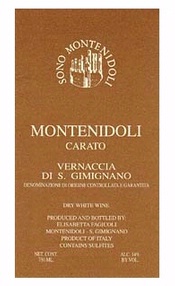 Carato, another Vernaccia di San Gimignano from the exemplary producer Montenidoli, is fermented and aged for a year in barrel before bottling. The winemaking here is so precise that you don’t taste woodiness. Rather, you feel the effect of wood on the wine — it’s a fuller, richer version of Vernaccia di San Gimignano that retains finesse and vigor. … Read more
Carato, another Vernaccia di San Gimignano from the exemplary producer Montenidoli, is fermented and aged for a year in barrel before bottling. The winemaking here is so precise that you don’t taste woodiness. Rather, you feel the effect of wood on the wine — it’s a fuller, richer version of Vernaccia di San Gimignano that retains finesse and vigor. … Read more
Montenidoli, Vernaccia di San Gimignano (Tuscany, Italy) “Fiore” 2012
($25, Artisans Wines, Inc.): 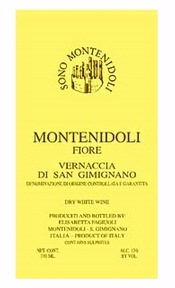 Montenidoli is one of the very best producers of Vernaccia di San Gimignano. Anyone who has been disappointed by this category of Italian white should taste their wines to see how grand this DOCG can be. Montenidoli makes three Vernaccia di San Gimignano; this one, made from free-run juice and labeled Fiore (flower) is, indeed, floral, fresh and clean. … Read more
Montenidoli is one of the very best producers of Vernaccia di San Gimignano. Anyone who has been disappointed by this category of Italian white should taste their wines to see how grand this DOCG can be. Montenidoli makes three Vernaccia di San Gimignano; this one, made from free-run juice and labeled Fiore (flower) is, indeed, floral, fresh and clean. … Read more
Montenidoli, Toscana Rosso IGT (Italy) “Sono Montenidoli” 2007
($55, Artisans Wines, Inc.): 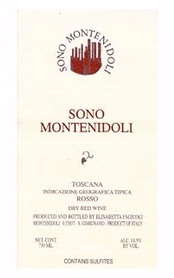 Since Montenidoli is one of the star producers of Vernaccia di San Gimignano, their red wines, such as this IGT Toscana, are often overlooked. That’s a mistake, since this one, labeled redundantly Sono Montenidoli for emphasis, is a sleeper of a Super Tuscan. … Read more
Since Montenidoli is one of the star producers of Vernaccia di San Gimignano, their red wines, such as this IGT Toscana, are often overlooked. That’s a mistake, since this one, labeled redundantly Sono Montenidoli for emphasis, is a sleeper of a Super Tuscan. … Read more
Badia a Coltibuono, Chianti Classico Riserva (Tuscany, Italy) 2010
($34, Dalla Terra Direct): Since the 2010 vintage was superb in Chianti Classico and Badia a Coltibuono is one of the star producers in that region, it is not surprising that this wine is stellar. Not boisterous, this is a classically proportioned Chianti Classico Riserva with great elegance and a seamless combination of bright red fruit flavors and earthy notes. … Read more
Badia a Coltibuono, Chianti Classico (Tuscany, Italy) 2012
($14, Dalla Terra Direct): This Chianti Classico reminds us that Badia a Coltibuono consistently makes attractive wines. The vintage was difficult in the Chianti Classico region because of less-than-perfect weather. Nonetheless, Badia a Coltibuono has fashioned a traditionally framed — that is, not overdone — Chianti Classico. … Read more
G. D. Vajra, Dolcetto d’Alba (Piedmont, Italy) “Coste e Fossati” 2013
($26): G. D. Vajra, one of my favorite Barolo producers, also makes excellent wines from other traditional Piedmont grapes, such as this Dolcetto. This is an unusual Dolcetto because the vines are over 100 years old and they are planted in a two vineyards — Coste and Fossati — that actually lie in the Barolo DOCG and could be planted with Nebbiolo and sold at a far higher price. … Read more
